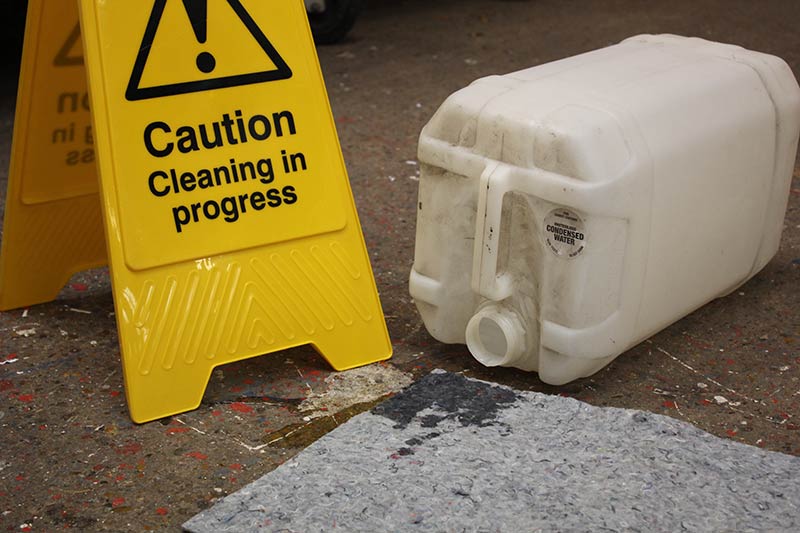Checklist to ensure you make the best response to a workplace spill
Workplace spill control procedures are required by law. The Health and Safety Executive states that businesses are required to have an on-site emergency plan in place to deal effectively with spillages. This will ensure compliance with Regulation 9 of COMAH.
General spillages are a major cause of slips and falls in the workplace and must be rapidly identified and removed in accordance with government health and safety legislation. When your staff have the best tools to clean spillages promptly, downtime can be reduced and the risk of accidents and injuries can be kept to a minimum. This will, in turn, lessen the risk of staff or visitors to your property taking legal action for compensation for injuries sustained as a result of a fall caused by a spill on your premises.

Chemical spills can not only cause harm to humans but can have major environmental impact too. So, having the necessary spill kits conveniently located in high risk areas will give you the best possible chance at containing spillages. And thus reducing wastage, improving clean up time and lessening damage to the environment.
Your emergency spillage plan should include staff training
Staff should be given full training on how to use spill control absorbents, which kits to use on which types of spill, and how to safely dispose of used absorbents.
Rather like tackling a fire, a trained professional should only tackle a spillage if it is safe to do so. Do not put yourself or others at unnecessary risk.
Location of spill kits is key
Spill kit locations should be carefully considered to enable fast and efficient spill control. Place your kits in areas which are at the greatest risk of a spill. Ensure that kits are in easy reach and not blocked by stock or machinery. All staff should be made aware of these locations. Appropriate signage would also be advisable.
If your work is in more than one area, for instance in a production environment, mobile spill kit storage trolleys designed to house absorbents allow you to relocate as necessary.
Identifying the source of a spill will enable you to select the correct spill control equipment
Once you have identified your type of spill, before you do anything, ensure the correct Personal Protective Equipment (PPE) is used.
In accordance with Health and Safety Executive regulations, PPE must be provided to enable employees to clear up spillages safely. Gloves and goggles should be worn for protection against burns from chemicals, with overalls and aprons also an option.
First and foremost attempt to contain the spill as much as possible, this can be achieved using absorbent snakes, pads and proprietary booms. Once a spill is contained, use absorbents to remove as much of the liquid as possible. Used absorbents must be disposed of as soon as possible. The method of waste disposal should be clearly set out in your emergency spill plan.
Oil and fuel spills
Specialist spill kits are required to deal with spills and leaks of oil and fuel. Spills of this nature can have a detrimental effect on the environment and should be contained as quickly as possible. Large-scale spills, such as from an oil tanker or fuel delivery lorry can also be incredibly dangerous in terms of flammability. These type of spills should be dealt with by the emergency services.
Oil and fuel spill kits will contain absorbent pads and spill socks specifically suited to soaking up oily liquids. Absorbent granules are another option for this type of spill, their non-flammable composition means they are safe to use on combustible substances.
Chemical Spills
One of the most destructive types of spill is a chemical spill. Harmful to health and the environment, chemical spills must be dealt with in a considered manner. As with all spills, the appropriate PPE should be used. Chemical spills do of course each have different properties. If you're unsure which chemical you are dealing with, surround the spill with chemical absorbent booms and socks to inhibit spread. Then apply chemical absorbent pads to the spill.
When a chemical is combined with another chemical, a reaction may occur which can emit toxic fumes and gasses. Ensure that masks are worn when taking care of chemical spills. Your emergency spillage plan should include evacuation procedures and name a designated person who is to initiate evacuation protocol.
Chemicals which are used regularly within an organisation should have the relevant neutralising treatment available nearby, as well as the appropriate spill kit. Large-scale chemical spills may require the Emergency Services.
Body Fluid Spills
A topic nobody likes to mention, and one to make you go 'Eeew', but in a situation where body fluids end up where they shouldn’t, you'll be incredibly glad that you had the forethought to purchase a bodily fluid spill kit! Bodily fluids contain bacteria, so look for a kit including germ killing solutions.
With spills of a bodily nature, keep people away from the area to minimise the spread of bacteria. Deploy a hazardous area floor sign to divert people away from the incident. Applying absorbent flakes to incidents such as vomit and faeces will make it possible to sweep them up and place in a hazardous waste disposal bag, included in the kit. Absorbent powders are also available, these are ideal as they contain broad spectrum disinfectant and can soak up 30 times the volume of powder applied.
Environmental considerations
An unfortunate by-product of a spill kit is waste. But, there are options available which are kinder to the environment. Opt for spill control products manufactured in the UK from recycled waste materials. They not only help to reduce the use of single use plastics, but boast 30% more absorbency than the average polypropylene pad. Spillage waste can sadly not be recycled as it is deemed hazardous, but opting for a recycled absorbent will still be the greener alternative.
Protect waterways from pollution from spills
All spillages must be contained as quickly as possible. It’s important to ensure that drains are covered to prevent contamination from spilled liquids. Include neoprene drain covers, gully covers and plug rug clay drain covers with all your spill kits.
Maintenance and restocking
Keeping check of your spill kits is essential. Your designated emergency spill plan representative should monitor all kits on a weekly basis. Checklists should be included inside all kits and should be dated and signed following inspection. Staff should be trained to alert your representative when any part of a spill kit is used in between inspections to ensure they always remain fully stocked.
Absorbents can be purchased separately and a stock of them should be kept in-house. These include pads, cushions, socks, booms and granules.
Spill kits supplies to suit your business size
Smaller kits are a great choice for garages, workshops and small warehouses, they can also be a practical solution for the home. But for heavier-duty industrial spills, you'll want to be providing high capacity kits such as the large 800L kits designed for large workplaces. They're designed for use on a selection of spill types and supplied with a large wheelie bin for disposal of your soiled absorbents. Refill kits are available for large workplace spill kits.
Mobile spill kits
When you're on the move you'll want to take your spill kit with you. Whether you're an HGV driver, coach or bus tour operator or even a forklift trucker, there are spill kits designed specifically for this purpose.
Don't wait until a spill occurs
Prevention is better than cure, but accidents happen. So don’t wait until the worst happens, get everything in place to ensure that you are able to deal with emergency spills safely and in a timely manner.

Author Bio - Debs
Digital marketer, social media, content writer, musician, sloth-lover, tea-drinker.




